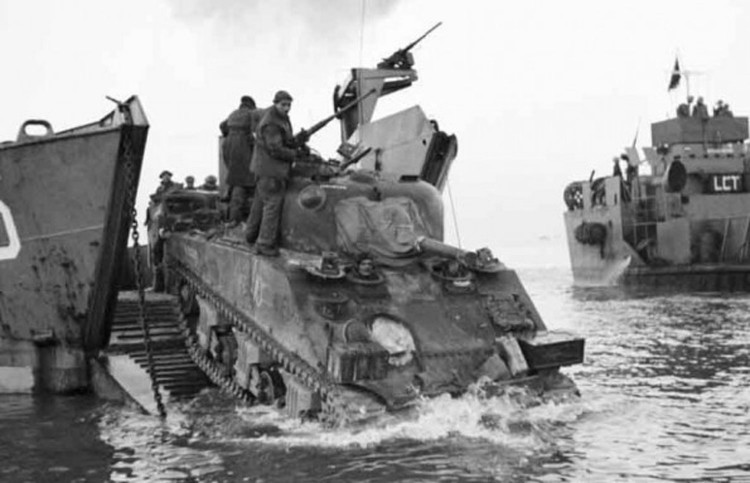Authors:
Historic Era: Era 8: The Great Depression and World War II (1929-1945)
Historic Theme:
Subject:
Winter 2019 | Volume 64, Issue 1


Authors:
Historic Era: Era 8: The Great Depression and World War II (1929-1945)
Historic Theme:
Subject:
Winter 2019 | Volume 64, Issue 1
In the predawn darkness of January 22, 1944, an amphibious force of 36,000 members of VI Corps, a joint U.S.-British command, and a part of Lt. Gen. Mark Clark’s combined U.S.-British Fifth army, was heading toward the German-held beach towns of Anzio and Nettuno, on the eastern coast of Italy, just 40 miles south of Rome.
The Germans weren’t expecting such an audacious operation. Since the previous October, German Field Marshal Albert Kesselring’s Army Group C had kept the Allies from advancing up the Italian peninsula by bottling up both Clark’s Fifth and Lt. Gen. Oliver Leese’s British Eighth Army below the Gustav Line, a formidable defensive line that ran the width of Italy and was anchored at Monte Cassino, 100 miles from Rome.
The Anzio-Nettuno invasion, known as Operation Shingle, was designed as an “end run” around the western flank of the Gustav Line. While the idea for Shingle had been Clark’s brainchild, it was nearly stillborn because so many American and British assets—men, materials, and shipping—were in the process of being diverted from the Mediterranean Theater to the United Kingdom in order to prepare for the upcoming Operation Overlord, the invasion of northern France.
But British Prime Minister Winston Churchill, who had fought long and hard to maintain a strong Allied presence in the Mediterranean (believing that it represented the “soft underbelly” of Hitler’s Europe), was an early and enthusiastic supporter of Shingle, and he pushed it forward even when others argued against it.
Churchill felt strongly that Kesselring would be so unnerved by an Allied landing behind the Gustav Line that he would panic and order the German Tenth Army to abandon its positions and high-tail it northward, leave Rome undefended, and perhaps even head all the way to the Alps.
Shelved and then reincarnated on a couple of occasions, Shingle was finally given a last-minute reprieve and put into action.
And so, hundreds of ships filled with men, tanks, and artillery pieces slipped out of Naples harbor after dark on January 21, sailed north, and began discharging men and their equipment onto the silent sands both north and south of Anzio-Nettuno the next morning.
Leading the operation was Maj. Gen. John P. Lucas, whose VI Corps had barely managed to hold the Salerno beachhead the previous September. For the next three months, VI Corps, along with Clark’s Fifth Army and the British Eighth Army on the Adriatic side of Italy, crawled their way north, battling both the rugged Apennine Mountains, the increasingly foul autumn weather, and the Germans’ tenacious defense.
Lucas, age fifty-six, was a solid, if uninspiring, leader not given to reckless, aggressive charges towards the enemy. And Clark, his superior, had not exactly demanded a hell-bent-for-leather charge from Lucas. “Don’t stick your neck out as I did at Salerno, Johnny, or do anything foolish,” he counseled his subordinate shortly before the operation began, adding, “You can forget this goddam Rome business.”

Lucas took his vague orders to mean that he was not expected to make a mad dash for Rome but, rather, make a landing, consolidate his beachhead, and wait for more troops and supplies to arrive before venturing very far inland. No one knew what the enemy’s reaction would be, but it was expected to be violent and powerful.
Splashing ashore in the dark, the British 1st Division and U.S. Third Infantry Division swiftly overcame what little opposition was thrown at them, marched a few miles inland, and then dug in to await further orders. The terrain around Anzio and Nettuno was virtually devoid of German troops.
The initial phase went as well as the planners of Operation Shingle could have hoped for; Lucas certainly thought so. He wrote in his diary with pride, “We achieved what is certainly one of the most complete surprises in history.”
This positive thought was confirmed when Clark and Field Marshal Harold Alexander, head of 15th Army Group and Clark’s immediate superior, visited the beachhead area later on D-Day to assess the situation and confer with Lucas; the two seemed pleased with the landings and the progress thus far. Alexander was especially happy that things had gone so well. Buoyantly, he told Lucas, “You have certainly given the folks at home something to talk about.”
As D-day wore on, and there seemed to be no enemy attempts to counterattack them, the men on the beachhead grew confused. One of the British soldiers grumbled, “What were we messing about at? Rome was only thirty miles up the road; we could have been drinking vino with the Pope by now.” It was a grumble shared by 36,000 others
With the lone paved Anzio-Rome highway wide open, getting to the capital city quickly would have been relatively easy, but the salient created by such a thrust up the highway worried Lucas. According to one 3rd Infantry Division officer, the slim column would have been mercilessly attacked and destroyed. “I don’t know why people don’t understand that,” he lamented.
Although caught by surprise but not without expectation, Kesselring reacted swiftly to implement contingency plans; he told 10th Army commander Heinrich von Vietinghoff to pull some of his divisions out of the Gustav Line